Physical Address
304 North Cardinal St.
Dorchester Center, MA 02124
Traumatic injury to the musculotendinous units of the elbow may result from acute trauma or repetitive micro-trauma. Furthermore, acute trauma is frequently superimposed on tendinopathy or other chronic injuries. MRI can be highly valuable in the assessment of elbow pain, owing to its superb soft tissue resolution. Even in patients with a clear clinical diagnosis of musculotendinous pathology, MRI can better establish the severity of injury as well as the presence of associated conditions.
Lateral epicondylitis is an overuse injury involving the extensor/supinator muscles that originate on the lateral humeral epicondyle ( Fig. 12-1 ). It is the most commonly encountered sports-related injury to the elbow. The condition is highly prevalent among tennis players, hence the term “tennis elbow.” The risk of overuse injury is increased two to three times in players with more than 2 hours of play per week and two to four times in players older than age 40 years. Although originally described in tennis players, lateral epicondylitis is commonly seen in the general population as a result of repetitive work-related activities.
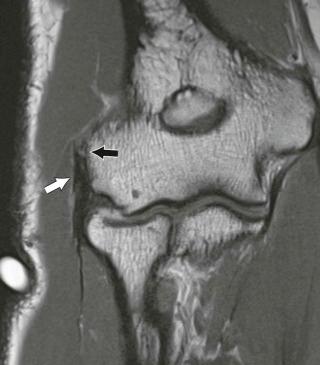
Medial epicondylitis is defined as a flexor pronator tendinopathy at its origin from the medial epicondyle. The tendon origins of the flexor carpi radialis muscle and pronator teres muscle are more commonly involved ( Fig. 12-2 ). Medial epicondylitis is similar to the more common lateral epicondylitis in many respects. Both conditions are overuse tendinopathies that can be associated with racquet sports. Sports activities that involve repetitive valgus and flexion stress at the elbow such as golfing, bowling, arching, weight lifting, and throwing sports have been associated with medial epicondylitis. Some authors have considered Little Leaguer's elbow a variant of medial epicondylitis. This condition, however, is a traction apophysitis of the medial epicondyle, which requires a different treatment course.
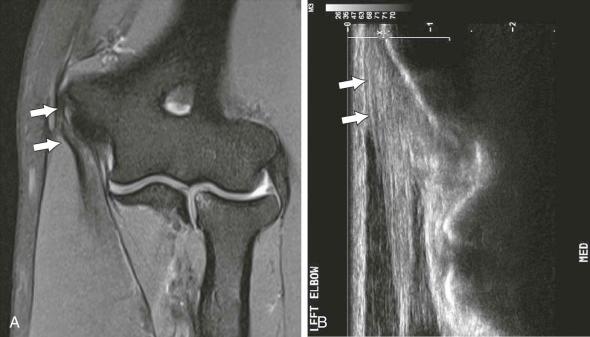
Medial epicondylitis is much less common than lateral epicondylitis, accounting for only 10% to 20% of all epicondylitis diagnoses. Medial epicondylitis is often found in the dominant elbow of a golfer. Tennis players who hit their forehand with heavy top spin are also at increased risk for developing medial epicondylitis. On the other hand, the annual incidence estimate of medial epicondylitis among workers was 1.5% in a recent study. The association of forceful work and the presence of other work-related upper limb musculoskeletal disorders with medial epicondylitis was found to be statistically significant. In this same study, repetitive work was not found to be a risk factor.
Acute rupture of the flexor pronator myotendinous unit can occur in association with ulnar collateral injuries, particularly after trauma during forceful extension of the elbow and pronation of the forearm by the throwing athlete (see for a demonstration).
Distal biceps tendon injuries most frequently affect the dominant extremity of middle-aged men. The spectrum of biceps tendon injury ranges from tendinosis to partial and complete tears. The vast majority of cases are the result of acute injury and often involve complete rupture. Distal rupture of the biceps tendon is at least 10 times less common than rupture of the proximal long head of the biceps tendon.
Triceps tendon rupture is a rather uncommon entity. Acute posterior elbow pain after a single traumatic episode is most often related to avulsion of the triceps tendon at or adjacent to its olecranon insertion. Triceps tendinosis as well as partial intrasubstance, myotendinous, and intramuscular tears may occur, although rarely. Although triceps tendon avulsion may affect both genders at a wide range of ages, it is most common in weight lifters, bowlers, baseball pitchers, and football players. Predisposing conditions for triceps tendon avulsion include hyperparathyroidism, chronic renal failure, diabetes mellitus, corticosteroid use, cortisone injections, total elbow arthroplasty, olecranon bursitis, subluxation of the ulnar nerve, and radial head fracture.
Another cause of posterior elbow pain has been referred to as the snapping triceps syndrome. This relates to transient subluxation of the medial head of the triceps over the medial epicondyle during elbow flexion. Several etiologic factors have been implicated and may include congenital, developmental, and posttraumatic causes. The condition has also been described in weight lifters in relation to triceps muscle hypertrophy. It often coexists with ulnar nerve dislocation.
The elbow joint has three primary stabilizing mechanisms: (1) the ulnohumeral articulation, which provides 33% of valgus stability; (2) the anterior bundle of the ulnar collateral ligament, which provides 54% of valgus stability; and (3) the ulnar lateral collateral ligament. Clinical experience suggests that greater than 50% integrity of the coronoid process of the ulna is required for elbow stability with or without ligamentous integrity. Also, greater than 30% of the articular surface of the olecranon is needed for stability. The secondary stabilizers include the radiohumeral articulation, the joint capsule, and the elbow musculature.
Injury to the ulnar collateral ligament complex occurs in overhead throwing athletes as a result of chronic repetitive valgus stress or, less frequently, acute trauma. The former may be an isolated finding or seen as a component of the so-called valgus extension overload syndrome. The latter can result from falling on an outstretched arm or may be secondary to posterior dislocation of the elbow. When injured as a result of repetitive microtrauma, such as seen in the overhead athlete, the anterior bundle is usually injured in its mid substance ( Fig. 12-3 ). In the setting of acute macrotrauma, rupture occurs most commonly in the proximal aspect of the anterior bundle of the ulnar collateral ligament complex. Avulsion of the sublime tubercle fills out the spectrum of possible injury involving the ulnar collateral ligament complex (see Fig. 12-3 ).
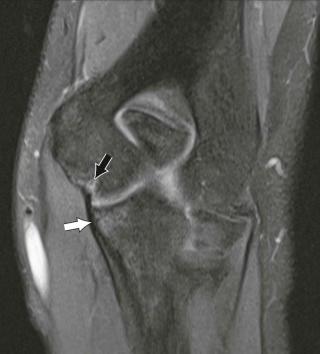
Chronic repetitive valgus stress results in a collection of microtraumatic injuries that occur when the elbow is repeatedly subjected to the considerable valgus stress intrinsic to overhead throwing. Athletes involved in baseball, tennis, football, volleyball, ice hockey, and water polo can be affected. Medially, the distraction forces, if excessive, outmatch the tensile strength of the ulnar collateral ligament complex. In the absence of the required period of recovery after this insult, the functional integrity of the ulnar collateral ligament complex is compromised. The end result can include (1) sprain of the ulnar collateral ligament complex, (2) medial epicondylitis, (3) ulnar nerve traction injury, and (4) avulsion injury to the medial epicondyle in the skeletally immature (see ) ![]() . Laterally, the compressive forces can result in chondral or osteochondral injury within the radiocapitellar joint with possible loose body formation. In this setting, valgus subluxation may also occur as a result of laxity of the ulnar collateral ligament complex.
. Laterally, the compressive forces can result in chondral or osteochondral injury within the radiocapitellar joint with possible loose body formation. In this setting, valgus subluxation may also occur as a result of laxity of the ulnar collateral ligament complex.
Injury to the lateral ulnar collateral ligament results (1) from chronic varus stress overload due to work, sports-related activity, or cubitus varus; (2) from an acute elbow injury such as posterior dislocation, hyperextension, or acute varus stress; or (3) as a complication of aggressive surgical treatment for lateral epicondylitis or radial head excision ( Fig. 12-4 ). Patients with insufficiency of the lateral ulnar collateral ligament experience laxity of the ulnotrochlear joint and secondary subluxation/dislocation of the radiocapitellar joint, while the proximal radioulnar joint retains its normal relationship.
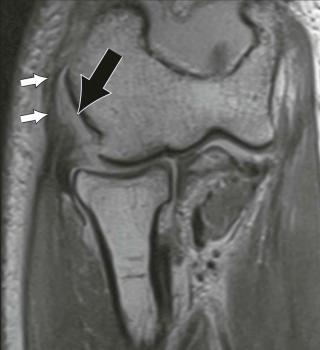
Elbow dislocation is the second most common major joint dislocation. The condition affects patients usually between the ages of 5 and 25 years. Fall onto an extended elbow is a frequent mechanism of trauma. Dislocations are classified based on the direction of dislocation, namely, posterior, posterolateral, posteromedial, lateral, medial, or divergent. Eighty to 90 percent of all elbow dislocations are posterior or posterolateral, affecting both the radius and the ulna, which are displaced in a posterior direction in relation to the distal humerus. Isolated dislocations of the ulna and radial head without associated fracture are rather rare in adults. Elbow dislocation is also classified into simple or complex depending on the presence of associated fractures. The most common complex dislocation is that associated with radial head fracture.
Alteration of nerve function secondary to compression by mechanical or dynamic forces may be a cause of upper extremity pain and weakness. Anatomically narrow passages predispose individual nerves to entrapment neuropathies. More often, the compression is related to space-occupying lesions, such as tumors, cysts, inflammatory processes, or to posttraumatic conditions, such as hematoma, myositis ossificans, and callus formation ( Fig. 12-5 ). Dynamic changes within a narrow space or tunnel during repetitive activity can result in entrapment of a nerve with only minimal anatomic variations.
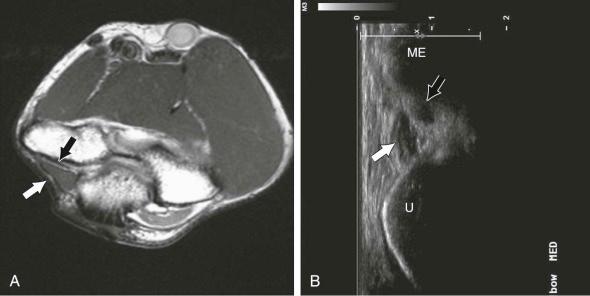
The wrist extensor tendons assist in stabilizing the elbow against varus stress. On repetitive varus stress, the musculotendinous complex may be subjected to eccentric loading and potential overuse as in lateral epicondylitis.
The flexor pronator group serves as a secondary stabilizer of the elbow joint, assisting the ulnar collateral ligament against valgus stress. Valgus stress is placed on the elbow by activities such as throwing and golfing. Valgus stress is particularly high during the late cocking and acceleration phases of the throw. Golfers place this area under stress during their swing: from the top of the back swing to just before ball impact.
The biceps is the most powerful supinator of the forearm, while also assisting in elbow flexion. Therefore, flexion or flexion-supination motions most often aggravate pain related to distal biceps tendinopathy. Rupture of the distal biceps tendon is most often secondary to sudden, forceful extension overload of the arm with the elbow in mid flexion. This mechanism of trauma is most common in weight lifters and rugby players. Distal biceps musculotendinous ruptures are typically associated with trauma occurring on glenohumeral elevation with the elbow extended and the forearm in supination.
Triceps tendon avulsion is most often secondary to acute trauma. The mechanisms of injury include (1) decelerating counterforce during active extension as in a fall with an outstretched hand; (2) direct blow to the tendon; and (3) forceful eccentric contraction of the triceps muscle with the elbow flexed. Relocation of the medial head of triceps tendon during elbow extension from the flexed position is responsible for the painful snapping sensation typical of snapping triceps syndrome.
The ulnar collateral ligament arises from the medial humeral epicondyle, slightly posterior to the central axis of elbow rotation. Therefore, it is under greatest tension with elbow flexion ( Fig. 12-6 ). The radial collateral ligament emanates from the lateral epicondyle at the central axis of rotation. Consequently, this ligament is constantly under tension regardless of elbow position.
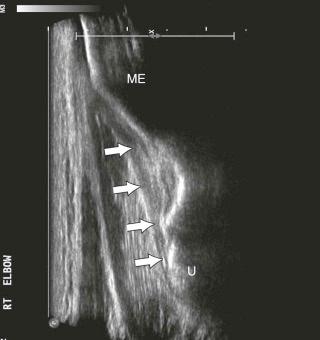
Ligamentous injuries of the elbow may be related to a single traumatic event, as in elbow dislocation or varus extension stress injury to the radial collateral ligament, or to chronic repetitive trauma with valgus stress to the medial collateral ligament. Injury to the lateral ulnar collateral ligament has also been reported as a complication of common extensor tendon release for treatment of lateral epicondylitis.
Elbow instability can be divided into three stages. In stage I, there is posterolateral rotational subluxation of the ulna on the humerus associated with supination or external rotation of the ulna related to disruption of the radial ulnar collateral ligament. In stage II, there is incomplete elbow dislocation with the coronoid process of the ulna perched on the humeral trochlea. This stage of injury implies tearing of the lateral ulnar collateral ligament and radial collateral ligament as well as anterior and posterior capsular disruption. In stage III, the coronoid process of the ulna is located behind the humerus. This stage is subdivided into A and B if the posterior bundle of the ulnar collateral ligament is disrupted and the anterior bundle of the ulnar collateral ligament is involved, respectively.
At the distal arm and elbow there are several potential sites of compression of the ulnar nerve. Compression at the cubital tunnel is the most common. In this location, the ulnar nerve is quite superficial and can be easily injured by direct trauma. The cubital tunnel experiences dynamic changes during flexion and extension of the elbow. The cubital tunnel is reduced in size during elbow flexion, as the overlying arcuate ligament becomes progressively taut. At 90 degrees of elbow flexion, the greatest tightness of the arcuate ligament is achieved. Further decrease in the volume of the cubital tunnel and medial displacement of the elbow nerve during elbow flexion are secondary to medial bulging of the ulnar collateral ligament and the medial head of the triceps. Increased cubital tunnel pressure with flexion has also been described.
The pronator syndrome is the most common cause of median nerve entrapment at the elbow. The four potential sites of compression that constitute the pronator syndrome from proximal to distal are as follows: (1) the supracondylar process/ligament of Struthers; (2) the lacertus fibrosus; (3) the pronator teres muscle; and (4) the proximal arch of the flexor digitorum superficialis muscle. Dynamic compression of the median nerve between the superficial (humeral) and deep (ulnar) heads of the pronator teres muscle is the most frequent cause for the pronator syndrome. Fibrous bands can be found in up to 50% of anatomic specimens located dorsal to the humeral head or to the nerve itself. These bands can produce nerve compression, particularly in pronation and elbow extension, when the distance between the two heads of the pronator teres is decreased.
Radial tunnel syndrome refers to compression of the posterior interosseous nerve within the radial tunnel without motor deficit. Potential compression sites of the posterior interosseous nerve within the radial tunnel include, from proximal to distal: (1) fibrous bands extending from the radiocapitellar joint; (2) the tendinous edge of the extensor carpi radialis brevis muscle; (3) the radial recurrent artery and branches (leash of Henry); (4) the arcade of Fröhse at the proximal edge of the supinator muscle ; and (5) a fibrous band at the distal end of the supinator muscle. Repeated pronation and supination or forceful extension of the forearm may result in dynamic compression within the radial tunnel. Tennis players, swimmers, housewives, welders, conductors, and violinists are frequently affected by this disorder. The posterior interosseous nerve syndrome is defined as a motor neuropathy. Trauma, space-occupying lesions, and inflammatory processes have been implicated as potential etiologic factors. Compression sites for posterior interosseous nerve syndrome are the same as those for the radial tunnel syndrome.
Nirschl and Petrone attributed the cause of lateral epicondylitis to microscopic tearing with formation of reparative tissue (angiofibroblastic hyperplasia) in the origin of the extensor carpi radialis brevis muscle from the lateral epicondyle. Increased signal intensity on T1-weighted and T2-weighted MR sequences is likely related to intratendinous mucoid degeneration and neovascularization. Over time, this microtearing and repair response can result in macroscopic tearing and structural failure of the origin of the extensor carpi radialis brevis muscle ( Fig. 12-7 ). The origins of the extensor digitorum communis and extensor carpi radialis longus tendons may also be involved. Furthermore, a large proportion of patients with moderate to severe lateral epicondylitis have associated lateral collateral ligamentous injury.
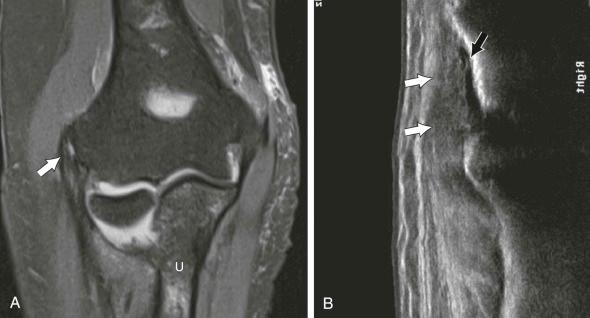
The pathologic findings of medial epicondylitis parallel those described for a disorder that affects the common extensor tendon, ranging from tendinosis to partial and complete tears. However, unlike with the common extensor tendon, the common flexor tendon is more susceptible to acute disruption. The close spatial and functional relationship of the common flexor tendon to the ulnar collateral ligament renders the two susceptible to concomitant injury. Injury to the ulnar nerve is also commonly seen in this context.
The most common site of distal biceps tendon injury is a few millimeters proximal to the osseous insertion into the radial tuberosity. Intrasubstance and myotendinous tears are rare. The distal biceps tendon has an area of relative hypovascularity just proximal to its insertion onto the radial tuberosity. This explains the increased susceptibility of the distal biceps tendon to injury, placing it as the most commonly torn tendon in the elbow.
Two distinct tendon contributions can be delineated at the radial tuberosity attachment corresponding to the long and short heads of biceps fibers in 35% of the population. The bicipital aponeurosis is of particular importance in the pathophysiology of distal biceps tendon rupture. Preservation of the bicipital aponeurosis will prevent proximal retraction of the distal biceps tendon. A torn bicipital aponeurosis may allow retraction of the distal biceps tendon into the distal arm.
The typical site of acute traumatic triceps tendon injury is at, or adjacent to, its insertion on the olecranon. Anabolic steroid abuse and local corticosteroid injections have been associated with detrimental effects on the mechanical properties of connective tissue, thus acting as predisposing factors for triceps tendon rupture. Spontaneous rupture of the triceps tendon has also been reported in patients with underlying chronic renal failure, secondary hyperparathyroidism, rheumatoid arthritis, and collagen vascular disorders.
Become a Clinical Tree membership for Full access and enjoy Unlimited articles
If you are a member. Log in here